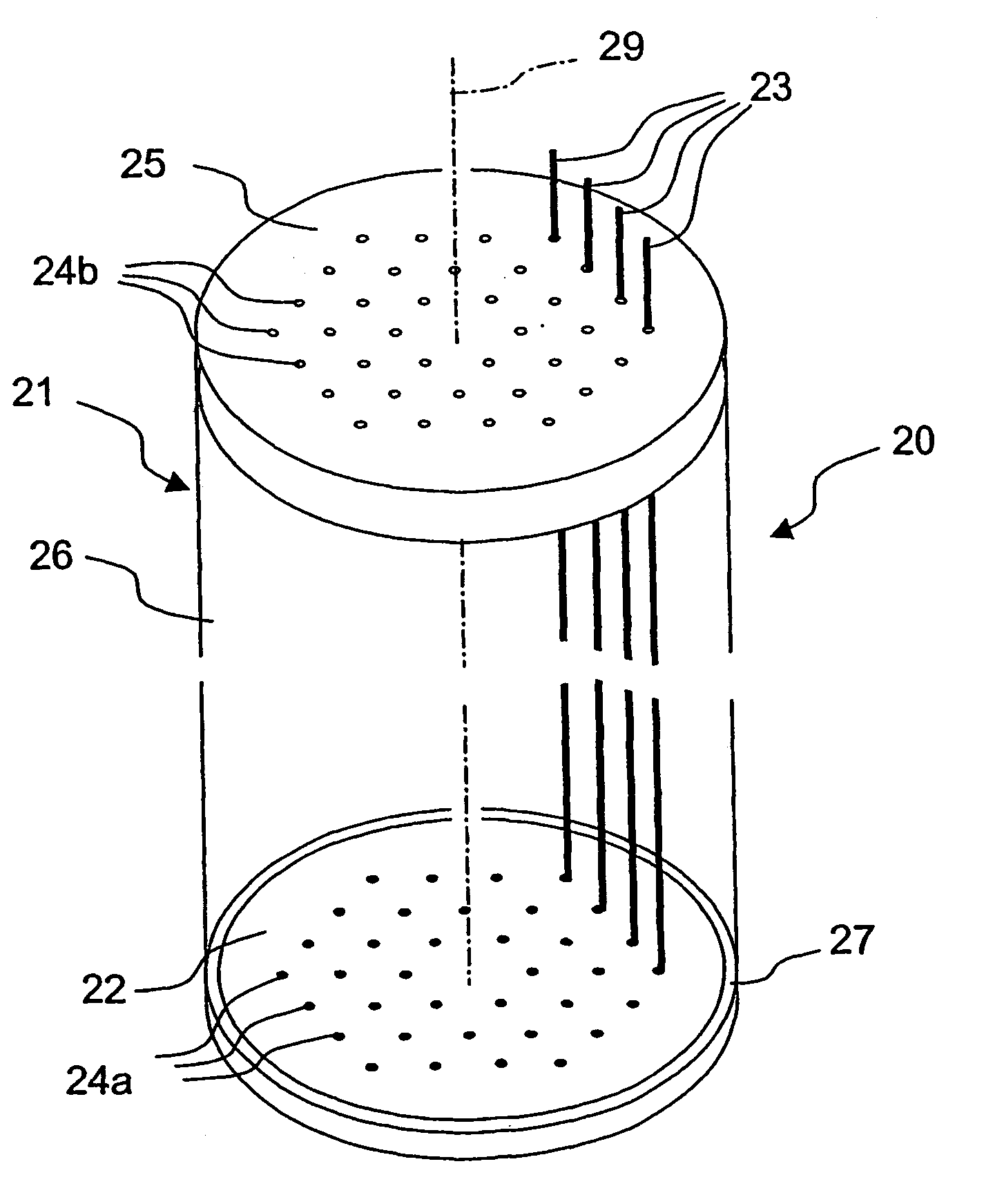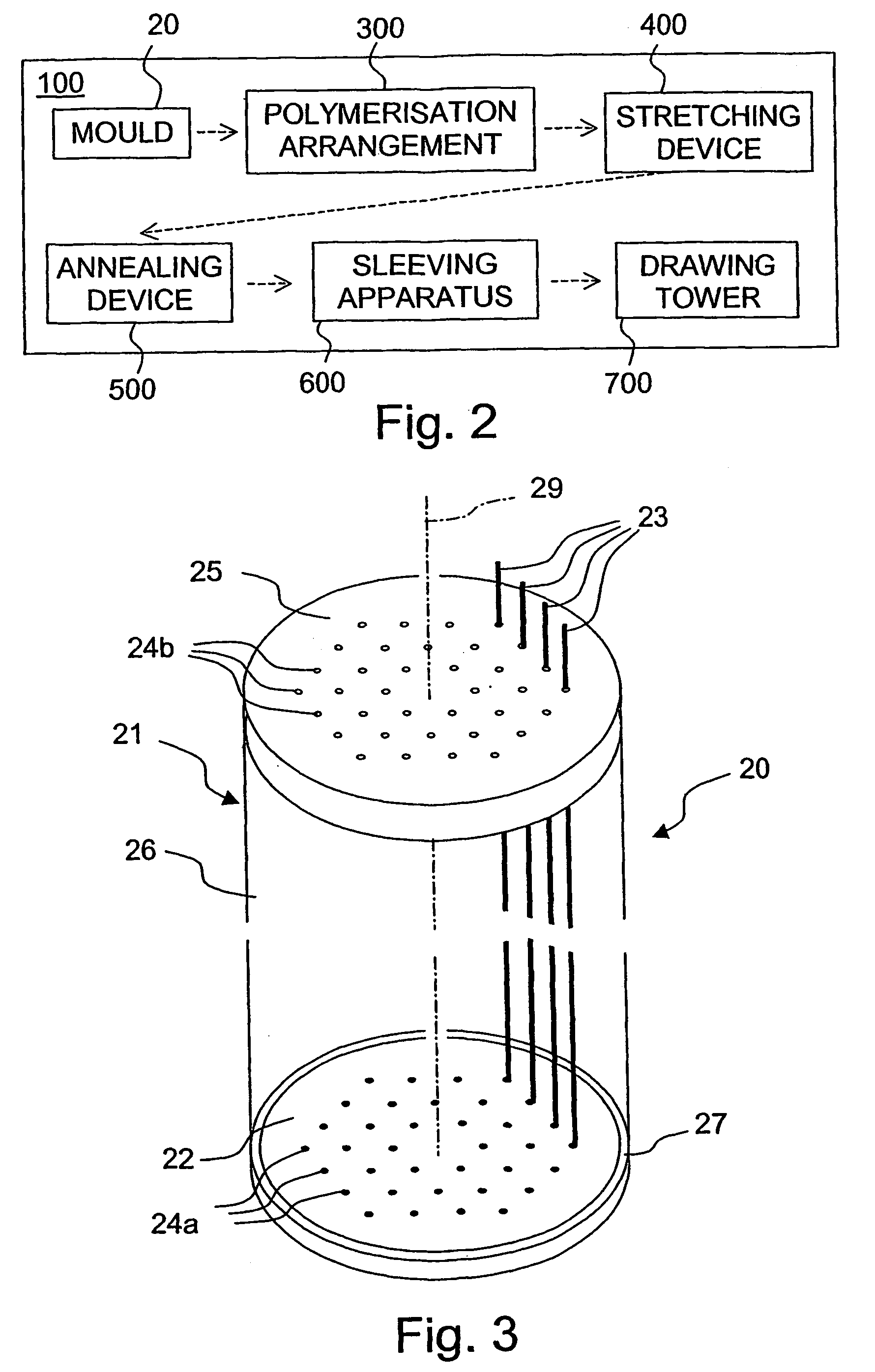Process for manufacturing a micro-structured optical fibre
a manufacturing process and microstructure technology, applied in the field of microstructured optical fibre manufacturing, can solve the problems of difficult extraction of preforms from moulds, and achieve the effects of slow cooling down, small values of ration d/d, and low quality of optical preforms
- Summary
- Abstract
- Description
- Claims
- Application Information
AI Technical Summary
Benefits of technology
Problems solved by technology
Method used
Image
Examples
example
[0100]Two coaxial crowns of holes are arranged around a central defect, consisting of a missing hole. The field amplitude distribution of the fundamental mode has been calculated for this structure by using the values of 1.4892 for the bulk refractive index and 650 nm for the wavelength, both values being typical of polymethylmethacrylate. As an example, the results for Λ=10 μM (Λ / λ=15.4), and d=1 μm (d / Λ=0.1) have been evaluated. In these conditions, the 1 / e equal intensity line falls inside the solid core, close to the inner crown of holes, and the effective area at 650 nm results as large as 680 μm2.
[0101]Therefore the connection between fibres of this type is eased. The plastic material is easy to cut and splice; moreover, the large effective area reduces alignment difficulties.
[0102]An assembly apt to manufacture micro-structured fibres of the types previously described is schematically depicted in the block representation of FIG. 2 and is here indicated with 100. Assembly 100 ...
example 1
[0181]500 ml of commercial methyl methacrylate (MMA) 99% (Sigma-Aldrich) were purified by passing through basic activated alumina powder (Sigma-Aldrich) in a glass column. The treatment removed the inhibitor and other impurities, supplying MMA of purity 99.7%.
[0182]The purified MMA was filtered with a 0.45 μm filter and inserted in a glass ampoule; 0.05% by weight of lauroyl peroxide 97% (Sigma-Aldrich) as initiator and 0.43% by weight of 1-decanethiol 96% (Sigma-Aldrich) as chain transfer agent were added. This mixture, freshly prepared or maintained at 4° C. in a refrigerator for a few days, was used for all the subsequent examples.
example 2
[0183]The container was a glass tube of internal diameter 28 mm, and length 250 mm. Two orders of holes, 0.55 mm in diameter, spaced 5.5 mm, were drilled on two aluminium covers, in a regular triangular arrangement around a central missing hole (FIG. 2). Stainless-steel wires of diameter 0.5 mm were inserted into the mould passing through both covers, which were fixed at the extremities of the tube by means of tie rods. The wires were bent at one edge and the other edge was inserted in and fixed to a template frame connected to the upper cover by threaded rods with nuts, which were used to tension the wire assembly. Tetrafluoroethylene seals and rubber o-rings were interposed between the covers and the glass tube, while the outer part of the covers was encapsulated in a polyurethane potting.
[0184]The mould so assembled was extensively cleaned from dust by means of a filtered solvent (ethyl alcohol) which was re-circulated through it with a peristaltic pump. The solvent was filtered ...
PUM
| Property | Measurement | Unit |
|---|---|---|
| Temperature | aaaaa | aaaaa |
| Pressure | aaaaa | aaaaa |
| Angle | aaaaa | aaaaa |
Abstract
Description
Claims
Application Information
 Login to View More
Login to View More - R&D
- Intellectual Property
- Life Sciences
- Materials
- Tech Scout
- Unparalleled Data Quality
- Higher Quality Content
- 60% Fewer Hallucinations
Browse by: Latest US Patents, China's latest patents, Technical Efficacy Thesaurus, Application Domain, Technology Topic, Popular Technical Reports.
© 2025 PatSnap. All rights reserved.Legal|Privacy policy|Modern Slavery Act Transparency Statement|Sitemap|About US| Contact US: help@patsnap.com



